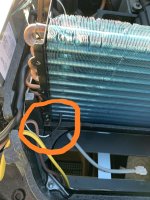That older metal style is probably a Bi-Metal on off thermal disc. Yes the one in my pic was part of the kit I added to upgrade from analog controls, and is a resistance style thermistor. That paired with the Micro Air thermostat, will actually show you the degrees in Fahrenheit on the screen for that freeze sensor.
But actually the Freon is pumped by the compressor as a gas to the condenser where it's condensed to a hot liquid, mostly cooled by the condenser, then flows to the metering device, whether it be capillary tubes, or a TXV. Once it enters the evap coil the liquid boils off to a vapor, which produces the "cold" affect, it then absorbs the heat transferred to that vapor through the fins of the coil, the now "super heated" vapor returns back to the compressor to be condensed to a liquid and start the process over.

